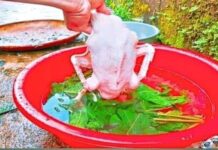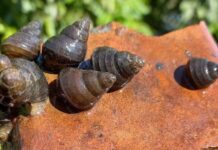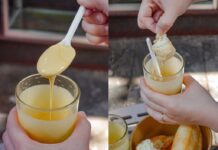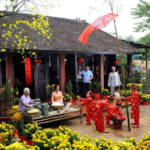Alocasia, or Elephant Ear, is a popular and familiar houseplant in Vietnam. If you’re interested in growing and caring for your own Alocasia plant at home, this guide will help you get started.
1 What is Alocasia?
Origin and Significance of Alocasia
Alocasia is a tropical plant native to Latin America. Also known as Chinese Taro, it typically does not have an above-ground stem, but instead has underground corms from which long petioles bearing leaves and flowers grow, reaching 15-30cm in length.
 Origin and Significance of Alocasia
Origin and Significance of Alocasia
Alocasia is commonly used as an ornamental plant in living spaces, creating a unique and beautiful landscape. For plant enthusiasts who like to collect, there are numerous varieties of Alocasia, featuring a diverse range of colors and shapes.
Feng Shui Significance of Alocasia
In Feng Shui, Alocasia represents tenacity and resilience. It is believed to bring good luck, prosperity, and success to homeowners, especially those with a fire zodiac sign.
 Feng Shui Significance of Alocasia
Feng Shui Significance of Alocasia
Characteristics and Classification of Alocasia
Alocasia is distinguished by its large, broad leaves with vibrant colors and a heart-shaped silhouette. The long petiole has a sheathed shape, and the roots are clustered. The flowers of Alocasia consist of a spathe and a spadix, with the spadix bearing numerous small flowers enclosed within the white spathe.
 Characteristics of Alocasia
Characteristics of Alocasia
Based on leaf shape and color, Alocasia can be classified into several types:
- Stained Alocasia: Features leaves with colorful spots.
- Black Velvet Alocasia: Boasts dark green leaves resembling luxurious black velvet fabric.
- Quan Yin Alocasia: The leaves resemble those of the Bodhi tree, with a mystical hue.
- Green Alocasia: Has heart-shaped, vibrant green leaves.
- Red Alocasia: Displays red leaves with eye-catching golden veins.
- Fruitful Alocasia: A feng shui variety with large leaves and unique green patterns.
- White Alocasia: Features white leaves accented by green veins, creating a striking contrast.
- Eternal Alocasia: Known for its longer leaves and larger, more robust plants.
 Classification of Alocasia
Classification of Alocasia
2 Benefits of Alocasia
With its large leaves, Alocasia is an excellent air purifier. Placing this plant in your home not only adds a fresh and vibrant touch to your space but also contributes to a cleaner and healthier environment. Alocasia thrives in shaded areas, making it ideal for indoor decoration, whether on a desk or in a garden.
 Benefits of Alocasia
Benefits of Alocasia
3 How to Grow and Care for Alocasia
Growing Alocasia at Home
Alocasia can be grown from seeds or corms, but corms are more commonly used as they are easier to plant. Look for healthy, clean corms without any signs of disease.
Once you’ve selected your corm, clean it and prepare a germination medium by mixing equal parts of coconut fiber and perlite. Bury the corm in this mixture and place it in a plastic container, keeping it in a cool, well-ventilated area for 2-3 weeks until the seedling emerges.
 Choosing and Germinating Alocasia
Choosing and Germinating Alocasia
Choose a pot that suits the size and variety of your Alocasia, keeping in mind that the plant can grow significantly over 1-2 years. For the soil, opt for a loose, fertile, slightly acidic mix with good drainage. A recommended ratio is 3 parts garden soil, 3 parts worm castings, 2 parts rice husk biochar, and 2 parts coconut fiber.
Fill the pot with soil, leaving a 3-5cm gap from the rim, and place the seedling in the center, covering its roots with soil. Water the plant afterward.
 Selecting a Pot and Soil
Selecting a Pot and Soil
Caring for Alocasia
To promote healthy growth, expose your Alocasia to direct sunlight for at least 2 hours daily, preferably between 7-9 am. Additionally, water the plant 2-3 times a week, and during hot summers, remember to mist the leaves to prevent wilting.
 Caring for Alocasia
Caring for Alocasia
Supplement the plant’s nutrition with organic fertilizers such as worm castings and cow manure, diluted and applied once a month. Additionally, use NPK fertilizers like 20-20-15, 30-10-10, or 20-20-20 to support its growth. Remember to prune old, diseased, or pest-infested leaves to maintain the plant’s health and prevent fungal infections.
Notes on Growing and Caring for Alocasia
After transplanting your Alocasia into a pot, you can promote faster root growth by using root stimulants like N3M, Bimix Super Root, or Roots 2. As the plant grows larger over 1-2 years, consider repotting it to provide more space for its roots to spread out.
 Notes on Growing and Caring for Alocasia
Notes on Growing and Caring for Alocasia
4 10 Beautiful Alocasia Pictures
 Stained Alocasia
Stained Alocasia
 Black Velvet Alocasia
Black Velvet Alocasia
 Quan Yin Alocasia
Quan Yin Alocasia
 Green Alocasia
Green Alocasia
 Red Alocasia
Red Alocasia
 Fruitful Alocasia
Fruitful Alocasia
 White Alocasia
White Alocasia
 Eternal Alocasia
Eternal Alocasia
 Alocasia in the Garden
Alocasia in the Garden
 Alocasia Indoor Decoration
Alocasia Indoor Decoration
This guide has provided you with information on how to grow and care for Alocasia, along with beautiful pictures of this plant. Stay tuned for more interesting articles from us!
Explore 12 Amazing Destinations for Biking Trips
Unlock Vietnam in a brand new way with an exciting biking tour! Discover the stunning beauty of the country with Dien May XANH’s top 12 must-see destinations. From sweeping plains to clear blue beaches and mountainous vistas – experience all the sights with your own personal cycling tour. Find your ideal route and set out for an adventure today!





































